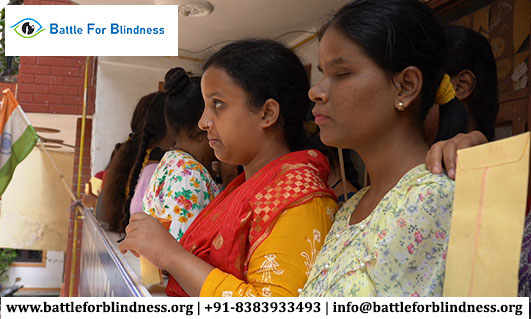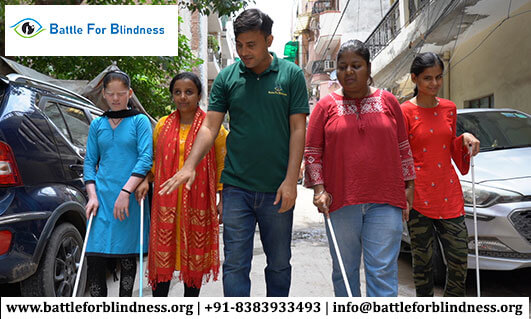
Access to public transportation is vital for fostering independence, mobility, and inclusion for visually impaired individuals. While global advancements in accessibility have made strides, India’s efforts towards creating an inclusive public transportation system are still evolving. In this blog, we’ll explore the global practices and highlight India’s progress in ensuring visually impaired individuals can move freely and independently.
Global Advances in Accessible Public Transportation
Globally, several countries have set the bar high when it comes to accessible public transportation, particularly for the visually impaired. Here are some notable advancements:
Talking Buses and Trains:
- In countries like the UK and the US, buses and trains are equipped with audio announcements that inform passengers of upcoming stops, delays, and detours.
- These auditory cues are essential for visually impaired passengers, helping them navigate public transportation systems confidently.
Tactile Guidance Systems:
- In Japan and some parts of Europe, tactile paving and guidance systems help visually impaired people find their way around platforms and busy transit stations.
- Special textured paths lead to crucial points like ticket booths, entrances, and platforms, improving accessibility.
Mobile Apps and Digital Assistance:
- In cities like New York and London, real-time mobile apps designed for the visually impaired provide detailed transit information, including bus and train schedules, alerts, and navigation support.
- These apps use GPS and other technologies to give clear, audible instructions to passengers, enhancing their travel experience.
Training and Support Staff:
- In many Western countries, public transportation staff receive specialized training on assisting visually impaired passengers. This includes everything from guiding them to their seats to ensuring they safely exit the vehicle.
India’s Progress in Accessible Public Transportation
India has made significant strides in improving accessibility for persons with disabilities, including the visually impaired. With the government’s flagship programs like the Accessible India Campaign (Sugamya Bharat Abhiyan), there’s growing awareness about the need for inclusive transport systems.
Accessible Metro Systems:
- Delhi Metro has been a forerunner in making public transit accessible to the visually impaired. Many metro stations feature tactile paving that guides visually impaired passengers from station entrances to the platforms.
- The Chennai Metro also offers similar accessibility features, including voice announcements, tactile paving, and ramps, setting an example for other cities to follow.
Bus Accessibility:
- Though India has yet to roll out a nationwide program like those in Europe or the US, several states have begun integrating low-floor buses with ramps to accommodate visually impaired and other disabled passengers.
- However, buses with audio-visual announcements remain rare in many cities, and greater investment is needed to make this a nationwide feature.
Efforts in Railways:
- Indian Railways has introduced several facilities for the visually impaired, such as Braille signs on station boards and platforms. In select trains, coaches feature Braille instructions for seat numbers, making it easier for visually impaired passengers to locate their seats.
- Audio announcements regarding train arrivals, departures, and platform numbers are becoming more common, though consistency across different regions remains a challenge.
Smartphone Apps and Digital Solutions:
- India has seen the rise of tech solutions for visually impaired passengers. For example, apps like Saarthi have been designed to provide audio-based navigation services, helping visually impaired individuals travel safely.
- The integration of real-time public transport tracking apps and GPS assistance has also gained traction, improving accessibility for those with visual impairments.
Challenges Still Faced by the Visually Impaired in India
Despite India’s growing commitment to accessibility, visually impaired people face several challenges when using public transportation:
Inconsistent Accessibility Features: While metro systems and select bus services in major cities have accessible features, rural and smaller urban areas often lack them. Inconsistent implementation of tactile paving, audio announcements, and Braille signage creates challenges for the visually impaired.
Lack of Awareness and Sensitivity: Public transport operators and staff often lack training in assisting visually impaired individuals. This can make it difficult for those with visual disabilities to seek help when needed.
Digital Divide: Although smartphone apps offer considerable assistance, a lack of access to smartphones and digital literacy among visually impaired populations can limit the benefits of these technologies.
Future Pathways for India’s Public Transportation
To create a truly inclusive public transportation system for the visually impaired, India must take several additional steps:
Government-Driven Mandates:
- The government should enforce accessibility standards across all modes of public transportation, including buses, trains, and metro systems.
- The Accessible India Campaign should be expanded to include mandatory audio announcements and tactile guidance systems in all major public transport facilities.
Technology and Innovation:
- India can learn from countries like Japan and the US by integrating advanced tactile guidance systems and mobile app technology to create a more user-friendly experience for visually impaired commuters.
- Investment in smart solutions, including GPS navigation and AI-powered digital assistants, can also enhance the mobility of visually impaired passengers.
Public Awareness and Training:
- Extensive training programs should be provided to public transport staff to help them better understand the needs of visually impaired passengers.
- Public awareness campaigns could also encourage passengers to offer assistance when needed, fostering a more inclusive travel environment.
Conclusion
Accessible public transportation is a critical aspect of social inclusion for visually impaired individuals. While global practices offer inspiration, India’s journey toward creating an inclusive transport system is still underway. Through sustained efforts, technology adoption, and government initiatives, India can pave the way for a more accessible future, ensuring that visually impaired individuals can navigate public transportation systems with confidence and independence.





